Remember What’s My Lot?, my web app that will tell you, if you’re on Prince Edward Island, what lot you’re standing in?
Now, in addition to being a regular everyday website, at whatsmylot.com, you can also install it as an app for Firefox or Chrome:
 |
 |
|---|
The Firefox web app can be installed on any device running Firefox – desktop, phone, or table – while the Chrome app cannot be installed on mobile devices (only because the Chrome Web Store isn’t available for mobile devices, oddly).
In addition to all the functionality of the original version of the app, the updated version now includes a thumbnail sketch of each lot’s original owner.
If you’re on a Mac using Firefox to install the app, you might have to adjust your security settings, temporarily, to allow the app to be installed.
I’m now 3 weeks into my experiment using a PiAware to track airplanes flying over Prince Edward Island. And I’ve been joined in the effort by my friend Ken, who, fortuitously, lives in Tyne Valley and thus is perfectly positioned to capture overflights that my receiver cannot see. As a result, coverage of all by the most western tip of the Island is very good now, as evidenced by this map that shows three weeks of flights:
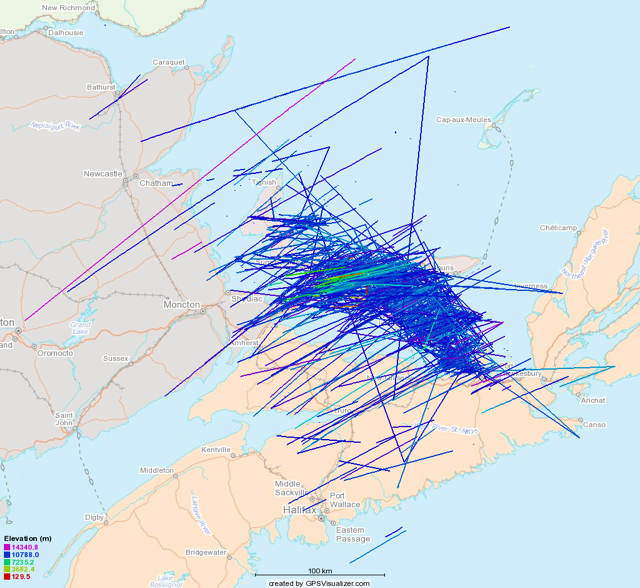
Some statistics about what’s flying over Prince Edward Island:
- The top five origins of planes flying over the Island are:
- New York, NY
- Newark, NJ
- Chicago, IL
- Toronto, ON
- Paris, France
- The top five destinations are:
- London, England
- Paris, France
- New York, NY
- Frankfurt, Germany
- Amsterdam, Netherlands
- The top five aircraft types are:
- Boeing 763
- Airbus 333
- Boeing 752
- Boeing 744
- Boeing 772
- The average altitude of flights is 35,474 feet.
- The maximum altitude was 47,050 feet. by a Wells Fargo Bank-registered flight that doesn’t allow its origin or destination to be published.
- The maximum ground speed was 671 knots (1242 km/h) by American Airlines 78, flying from Dallas to London on March 28, 2015.
More than anything else, this project has changed my perception of Prince Edward Island in the world: it’s a lot harder to think of PEI as a remote island disconnected from the global commerce when there are so many airplanes flying directly over our heads every day going to all corners of the earth. Even if they are 14 km above our heads.
After Hurricane Juan in 2003 I wrote, in my diary of the events surrounding the storm:
Catherine gets up with an awful barometric headache, and decides to sleep in Oliver’s bed just in case a tree falls on him. I try and get to sleep.
Here’s the tree I was afraid might fall in the storm:
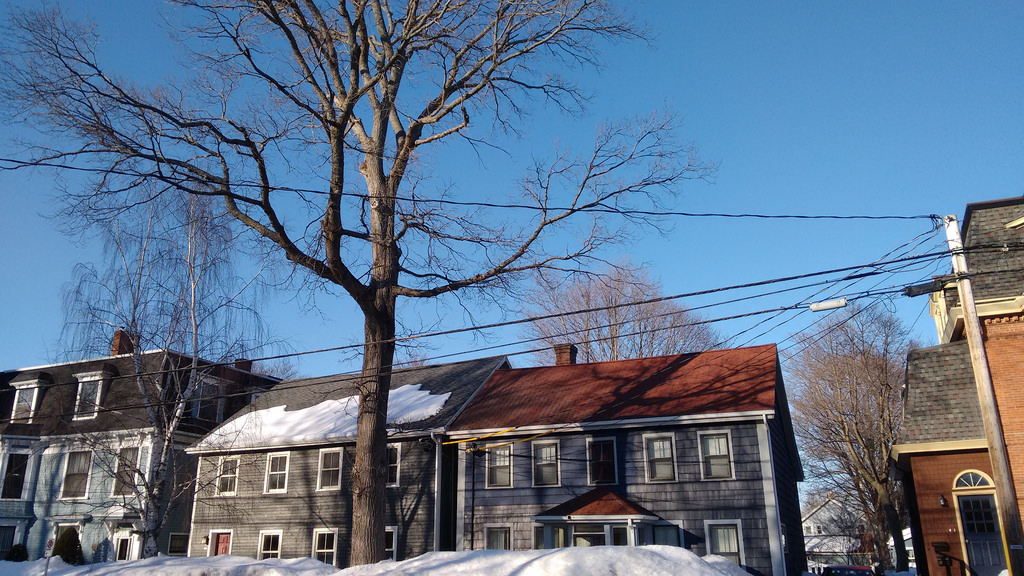
Our house is the blue one with the red roof; Oliver’s room at the time was on the left on the second floor. Of course if the tree fell it would have crushed the entire house, not just Oliver.
This morning at 7:30 a.m. we were greeted with a knock at the door by a worker from Asplundh, the contractor that’s cutting down more than 300 elm trees in Charlottetown as a reaction to Dutch elm disease.
“That your red car?”, he asked me, going on to explain that he needed to set up in front of our house and I either needed to move my car or face having it blocked for the rest of the day.
“Is that a big tree,” I asked, “compared to the others you’re taking down?”
“Just another day at the office,” he replied.
Here’s Oliver, this morning, now 11 years older, watching the tree on the cusp of falling to the chain saw:
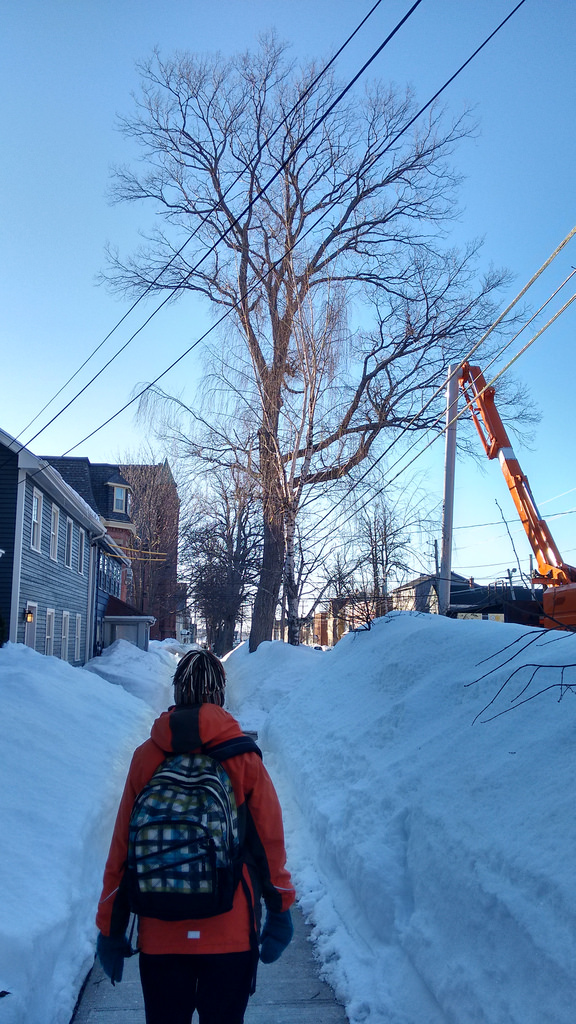
And here, courtesy of my friend Ray, are the remains of the tree a few hours later:
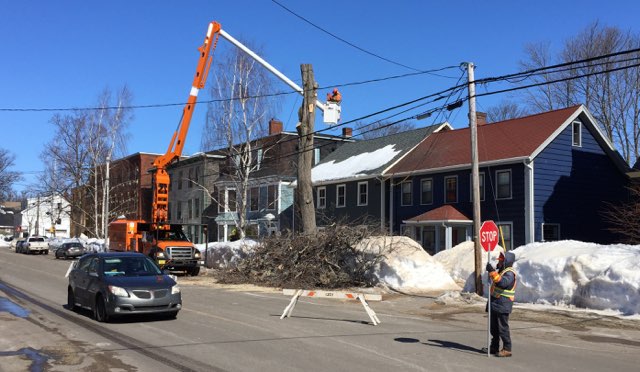
How long was the tree there? Back in 2005 I posted a photo of Trinity United Church, likely taken in the late 1870s or early 1880s, with a bit of our house in the corner; blowing the photo up, you can clearly see a tree (or trees) in the front yard of our house:
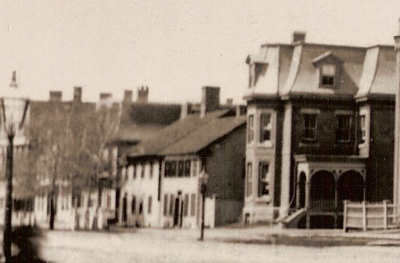
Was our elm one of those? I don’t know. At the very least, though, it was older than any of us. And perhaps the physically biggest natural object that’s every been a part of my daily life.
That tree will be missed.
Using Mita’s post as both inspiration and template, here’s a snapshot of my hardware and software setup as of the spring of 2015.
Infrastructure
My office is on the second floor of The Guild in downtown Charlottetown, about 4 minutes walk along Richmond Street from my house. It’s 286 square feet of open space with large windows looking town Queen Street to the water. The only downside of this location is that the theatre in The Guild is a paper-thin wall away, meaning that if there’s a Battle of The Bands, or a long run of Anne & Gilbert in the theatre, the effects can be mind-altering. On the upside, though, every Tuesday morning that are babies and infants being entertained by The Music Man, and what’s not to love about that.
In addition to the second floor space, we also rent a corner of the old PEI Printmakers Guide studio in the basement, which is where my letterpress printing operation is housed.
My office desk is a piece of government surplus I bought at The Clearance Centre in Summerside on the advice of my ergonomics consultant, its chief selling point being a crank that allows it to be adjusted up and down. My desk chair is a custom-made chair from Chairs Limited in Dartmouth; it adjusts in all the right ways. It was the best office investment I’ve ever made.
Hardware
I have one computer in my office, a 4-year old MacBook Air that has served me well. It has an internal 256GB SSD disk which I’m always in danger of filling up, so most of my working files are stored on an external 500GB Western Digital USB My Passport drive. I also have a 1TB LaCie external drive that I use to make a bootable SuperDuper! backup of the Mac so that I can keep working if (when) the main drive fails. I made a bootable backup about once a week.
The MacBook Air is plugged into a 27 inch Apple Thunderbolt Display that I purchased refurbished from Apple when my old 23 inch Apple Cinema Display stopped working. I’m still getting used to its size, and it’s possible that it’s actually too big for ergonomic purposes. But it has some lovely features, like a built-in power adapter for the MacBook, internal speakers and several rear-mounted USB ports.
My keyboard is a Microsoft Sculpt Ergonomic which I appreciate for its design and small profile, that lets me move the right-hand mouse closer to the keyboard. I also use the external numeric keypad that came with the Sculpt, but only when I’m keyboarding a lot of numbers. The Sculpt replaced a long line of Microsoft Natural Keyboard 4000s, the design and keyboard layout of which I preferred, but the integrated numeric keypad on the 4000 made the keyboard too wide for comfort and too wide to easily fit into my suitcase for travel. I keep a second Sculpt at Yankee Publishing in New Hampshire to use when I’m working from that office.
I have a Matias Ergo Pro keyboard on order, a purchase made largely on the strength of this review. It’s due to arrive in April, and I’m interested to see whether it’s an improvement over the Sculpt.
My mouse is a classic Apple wired “Mighty Mouse,” with the roller ball that’s forever getting clogged up. My hand is used to it to the point that I find using anything else awkward. I’ve tried the “Magic Mouse” from Apple, and various trackpads, but none has worked out. I always have a spare Mighty Mouse in the office in case (when) the working mouse stops working.
The office printer is an ancient HP PSC 2355 inkjet printer/scanner that, oddly, crashes every night so that when I arrive at the office there are cryptic error messages on its tiny screen. But this has no effect on its ability to print.
Here in the office there’s a Raspberry Pi with a DVB dongle that’s detecting airplanes overflying PEI and sending the data to FlightAware and a dedicated piece of radio receiver and Ethernet hardware connected to an external antenna picking up AIS marine ship location reports and sending them to MarineTraffic.com. There’s also a RIPE node powered by a TP-Link MR3020.
In the basement of the office there’s a Golder Jobber № 8 letterpress that turns 100 years old next month, and a much smaller Adana Eight Five tabletop letterpress; along with the presses, up here in the office (“composing room”) is a select of wooden and metal furniture, leading, and about a dozen fonts of metal type all store in a Hamilton typecase.
At home we have a relatively ancient iMac that gets mostly used by [[Catherine]] and our friend G. It’s handy to have for times when my mobile phone alerts me to server issues at midnight, though, even if it does take 4 minutes to boot up.
I was given an iPad 2 as a gift shortly after it was released, and I keep it in the office for iOS app development testing, but I haven’t actively used it as personal device for over a year.
My phone is an Android-powered Moto G 2nd generation, which I used to replace a Moto G 1st generation that I passed on to [[Catherine]]. Truth be told, after using the 2nd generation for several months, I prefer the old phone, as it fit in my hand much better and allowed for easier one-handed operation. I like the Moto G for its simple design, and for its relatively-plain-vanilla-Android experience.
I don’t have an ebook reader, mostly because the ergonomics of reading books digitally doesn’t work for me.
Under our televsion (a 25 year old pre-HD Sony Trinitron) is a Nintendo Wii (used mostly to steam Netflix) and a Raspberry Pi running the Kodi media centre and a variety of Kodi plugins, like Google Play Music, YouTube and USTVnow. We “cut the cord” 3 years ago, which would have perplexed my 12 year old self (who lusted for the cable TV that all the cool city kids had) but which was an excellent move.
Also under the TV is a second Raspberry Pi, which sends our water and electricity consumption to the Social Consumption Project.
Desktop Software
Alfred is at the core of my desktop workflow: I would find it difficult to use the Mac without it. I have a lot of custom workflows set up so that, for example, I can Control + Space and then type “ruk titanic” to search my blog for mentions of “titanic” or “ticket Fix the server problem” to create a trouble ticket, via email, to fix technical issues.
I use (the Canadian-made) 1Password to maintain my passwords for everything, and I run it on my MacBook, on my Moto G and on my iPad. 1Password’s Mac client is highly-evolved and a joy to use, as is the iOS client. The Android client works reliably, but has a kludgy user interface that I’m hoping gets improved with the next release. I use unique, long, complicated, randomly-generated passwords for everything I do online, and 1Password makes that possible.
Firefox is the browser I spend almost all of my time in. I’ve flirted with Safari, which is faster on the Mac, but absent on Android, and I’ve flirted with Chrome but have never taken to its user interface quirks. Firefox runs on my Mac and on my Android phone, and I use Mozilla’s services to sync my bookmarks and tabs across devices. I increasingly seem to be in the minority in the web development world, at least as regards the teams I’m working on, with Chrome being the go-to browser; this isn’t such a bad thing, as I’m the go-to “but it doesn’t work in Firefox” member of the teams.
Inside Firefox I use the 1Password, google-no-tracking-url, and JSONView add-ons, along with an ownCloud Booksmarks add-on that I hacked together myself and should really release into the wild.
Otherwise, I use Skype for most video conferencing (it’s the most widely adopted in my network), Apple’s stock Mail, Contacts, Calendar and Reminders apps (synced via ownCloud) for personal information management, Evernote for managing my bills (I scan or import all of my bills for everything home and business into Evernote, set reminders for when to pay, and everything just works; it’s by far and away the most reliable bill-payment workflow I’ve ever devices).
I use Apple’s Pages and Numbers as a word processor and spreadsheet; I’ve experimented with OpenOffice, but it never sticks.
I use GraphicConverter to edit raster images, and OmniGraffle to make and edit vector images.
For web development and programming work, which is what I spend most of my time doing, I use BBEdit as a text editor (occasionally I flirt with TextMate), Transmit as an SFTP client, GitHub’s OS X client as a GUI for managing git repositores, and Navicat as a MySQL client. I use Apple’s stock Terminal app to SSH to remote servers.
For mobile app development I used Xcode and Android’s SDK tools, but mostly I used BBEdit and the Cordova command-line tools.
Other apps on my Mac that I use only occasionally (i.e. they don’t have a home in my Mac OS dock): Audio Hijack Pro (for capturing audio from the web), Doxie (for driving the tiny scanner I occasionally use to scan bills and other paper things), Elastics (for managing EC2 instance; appears to no longer be on sale in the App Store), GPSBabel (for converting between GIS data formats), QGIS (for making and editing GIS maps), JOSM (for editing OpenStreetMap), MacFamilyTree (for managing family history data), Minecraft (for playing with Oliver in the dedicate world we’ve built ourselves), OmniDiskSweeper (for when my disk fills up and needs to be pruned), PDFpenPro (for editing and OCRing PDF files), S3 Browser (to upload and download files to Amazon S3), Skitch (for making screen shots; I use an ancient version that had support for SFTP; newer versions have lost almost all their utility for me), SSH Tunnel Manager (for doing strange port forwarding things), and Telephone (for making VOIP calls).
Web Software
I use both my own webserver and Flickr to post photos to the web; I’m inconsistent as to which I choose.
I have a Facebook account, but only reluctantly. Similarly, although with somewhat more gusto, I’m on Twitter. I flirt with other social media services, but none very seriously.
I’ve weaned myself off most Google-operated services over the last year (save for Android, which is one big Google-operated service, I suppose): I host an ownCloud server on an Amazon EC2 instance, and I use it to sync my contacts, calendars, bookmarks, and reminders; Catherine uses it to, so we have a family calendar that’s synced to all of our devices, which makes keeping track of complicated family life much easier. The ownCloud server has proved very reliable and, at least so far, CalDav and CardDav support in iOS, OS X and Android means that it integrates well into the native apps on all my devices.
I also use ownCloud as an external storage device; it’s largely replace Dropbox, iCloud Drive and Google Drive for me (although I keep accounts on all of those for situation when others share things with me using those services).
Earlier this year, after running my own IMAP and sendmail servers for almost 20 years, I migrated all of my mail serving needs to FastMail and I’m extremely happy about the move, both because FastMail had proved rock solid and because I don’t have to worry about maintaining servers, filtering spam and the like.
I replaced Google Reader, when it was retired by Google, with a self-hosted Tiny Tiny RSS server.
I run a Asterisk VOIP server on a dedicated Amazon EC2 micro instance using the PBX in a Flash set of software, utilities and documentation. This runs both our office and home phone systems; I have phone numbers in Charlottetown and in Dublin, NH that we rent from Vitelity, which I’ve been using for years and have always been happy with.
I continue to maintain a dedicated white box server over at silverorange, but I’m (slowly) migrating websites and services from it onto an Amazon EC2 instance that I use, right now, to power this blog, my ownCloud server, and a variety of other experiments. It pained my to “move into the cloud,” but the cost and flexibility of renting someone else’s hardware, and the fact that many of my clients are using EC2, made it the right decision.
On that EC2 instance I run stock Amazon Linux, Apache, MySQL and PHP and it’s Drupal 7 that powers this blog. I back up the EBS volumes that I use for storage with automatic snapshots taken every night, and I keep weekly and monthly snapshots for archival and rescue purposes.
Oliver and I rent a cheap Vultr instance to run our private father-and-son Minecraft server.
I subscribe to Google Play Music (after finding the Rdio clients to flaky to be useful), and connect to it using the stock Android app on my phone and using Radiant Player on my MacBook.
Phone Software
After being a long time Nokia Series 60 adherent, I flirted with Windows Phone and Firefox OS before settling on Android.
I use Type Mail as an email client (to overcome some serious IMAP bugs in the stock Android email app), Press to read RSS feeds (served using Fever emulation from my Tiny Tiny RSS server), Authenticator Plus to mange 2-factor authentication (it’s a huge improvement over the standard Google tool for this, mostly because it allows me to backup and restore services), Yatse as a remote control for our Kodi media server and SeriesGuide to help me figure out what to watch on TV.
I run the Android clients for Evernote and 1Password as a companion to the desktop clients, TaskSync to sync reminders with my ownCloud reminders, and the stock Google Calendar app to sync events with my ownCloud events.
I listen to podcasts using Pocket Casts, and use the standard Flickr, Twitter, Wikipedia and Wiktionary apps for those services.
Coffee and Food
The office is equidistant from my two go-to coffee places, Casa Mia and Receiver Coffee; I also occasionally make the trip down to the newfangled Kettle Black and, very rarely, to Starbucks (mostly when someone asks to meet me there). I don’t understand how people who don’t work downtown can cope with lack of coffee access.
I eat lunch out 5 days a week.
One or two days a week I go to Tai Chi Gardens on Pownal Street where I always order the Curry Veggie Rice for lunch, accompanied by either a pot of oolong or green tea (in the winter) or a lemon ice tea, no sugar (in the summer).
Once a week I’ll walk down Queen Street to Phở Hưng for Vietnamese food. Again, I always order the same thing, a “C3 with no egg,” which is a plate of spicy seafood fried rice accompanied by a bowl of chicken soup. Phở Hưng is one of the best things to happen to Charlottetown ever.
Otherwise I take lunch at Café Thomas Martin, Casa Mia Café, Mr. Sushi, or Ta-ke Sushi.
I need to drink more water in the office, but I’ve yet to find a reliable water-drinking scheme. Probably because I over-think the issue.
And that’s it…
Okay, so I went a bit overboard, but Mita set the bar pretty high.
And like Mita, I would love to know what your setup is.
Once I discovered that I had a letterpress cut of Alex B. Campbell’s signature in my collection, I needed to print something that took advantage of this lucky happenstance. And I found my inspiration in his biography, a passage from a speech he delivered at the Canadian National Exhibition in 1967 that came to be called the “I am a Canadian” speech:
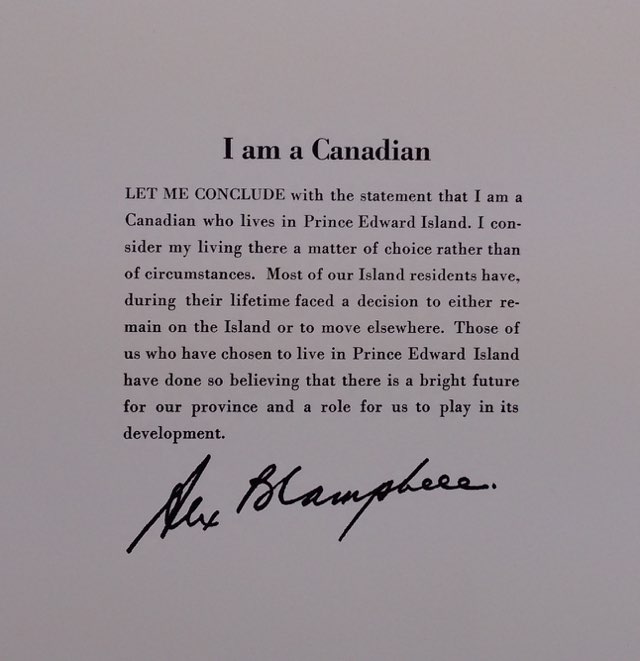
This was a two month project–two months with lots of breaks along the way, so really only a day here and a day there. If you look at the original typesetting you’ll see that I started off with the text ragged right, but I took the extra step of justifying it, and I’m very happy with the result.
The small caps of “LET ME CONCLUDE” are a hack: otherwise it was too difficulty to make the justification work without some additional hyphenation.
And I’ve debated the capitalization of “am” in the heading with several people, but always came out believing it should be lower case: partly for stylistic reasons, and partly to avoid conflation with the “I Am Canadian” campaign. Even if it is, according to grammar, Wrong.
It took a lot of adjusting of the Golding Jobber № 8 press to get even impression across the text; it’s still not perfect, but it’s much, much better than when I started.
The sentiment of the passage is one I deeply believe in myself – why else would I live here?
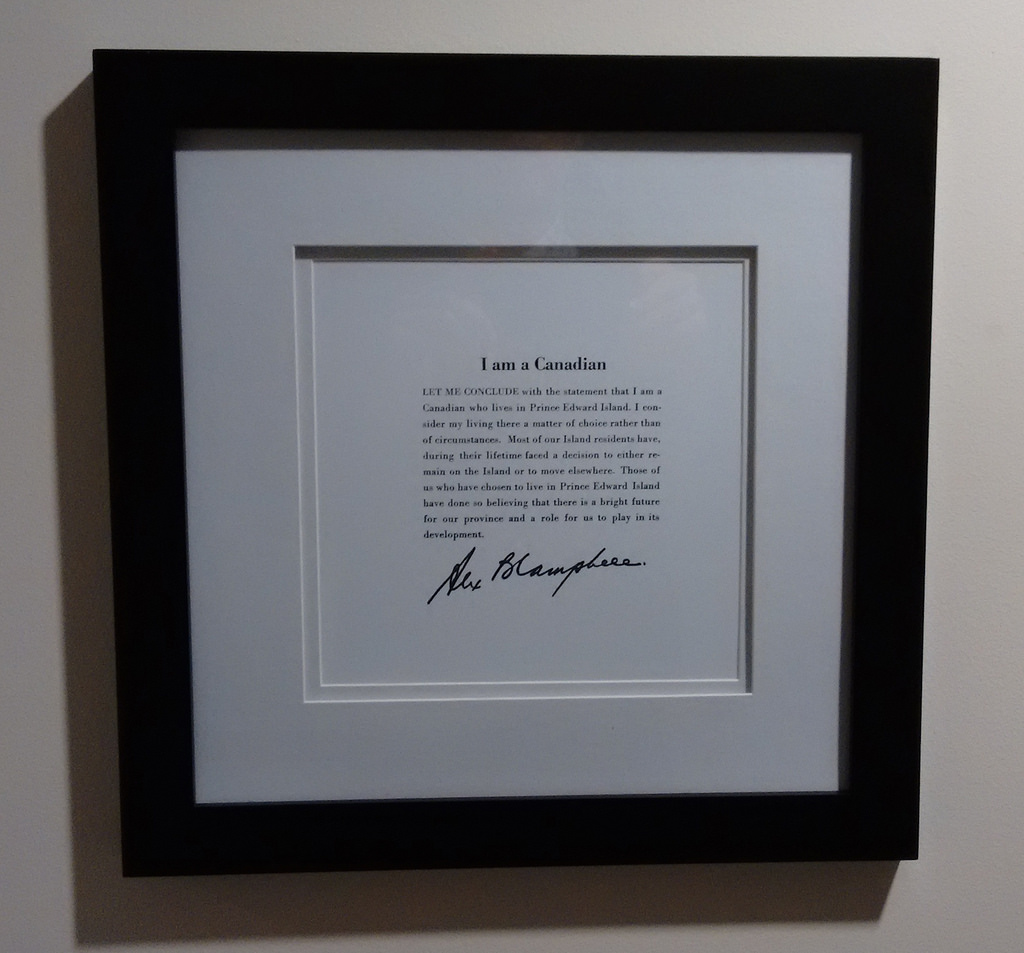
A month ago my arch enemy was snow.
As spring gradually arrives, it’s water that’s the new foe: with 5 feet of snow in our backyard (and I am not exaggerating) and temperatures forecast to be above 5ºC tomorrow, we’re preparing for waterfalls in our basement.
Fortunately, unlike others with modern basements, we have a 1820s-style foundation in our house that is no barrier to water at all, and so no real expectation of keeping the basement dry. Our job is to allow the water in and then to assist it in getting out, via our team of sump pumps, as quickly as possible.
To this end, we had a plumber in this morning with a jack-hammer to dig a new trench from the area around the furnace over to sump pump number two: this has been the weak point (requiring a shovel-equipped Catherine to waft water from one half of the basement to the other) in previous winters.
Now all we can do is wait.
Meanwhile, my roof-raking strategy paid off big dividends, as you can see from the side-by-side comparison with our neighbour:
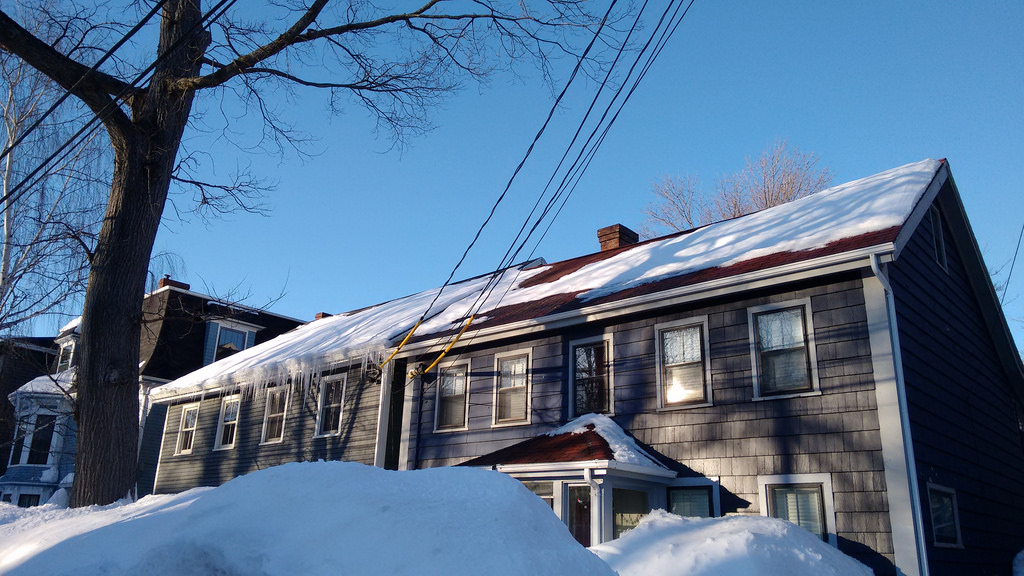
I’ve been out after every snowfall with the roof rake – sometimes three or four times a day when it’s been storming – and so I’m happy to report that we’ve been completely free from ice dams since our original issues arose. Although I can’t believe I’m writing this, I think I’m actually going to miss raking the roof once spring arrives in earnest.
Twenty years ago this winter, in January of 1995, I signed a 3 month contract with the Government of Prince Edward Island “…to establish a Gopher/World Wide Web service for PEI…”
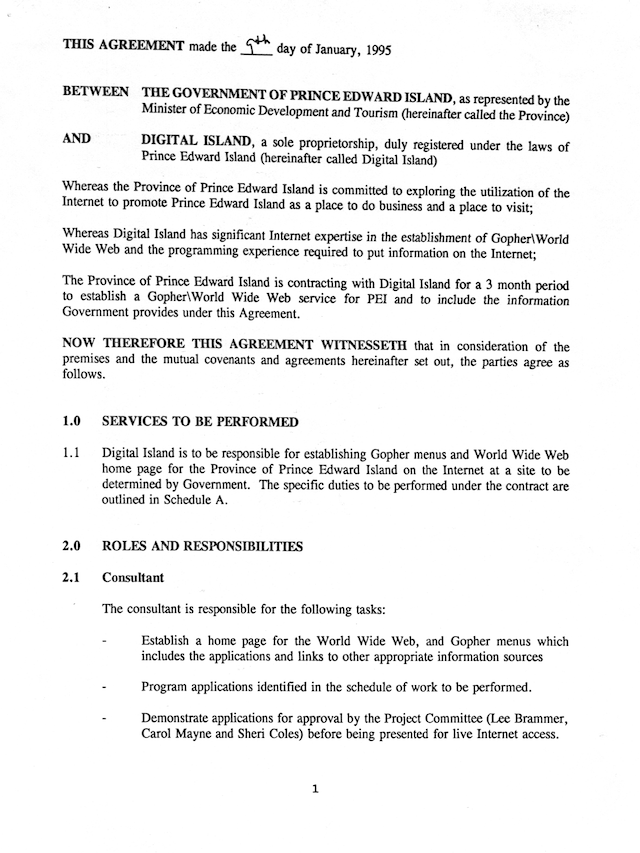
The inspiration for any travels I’ve taken with [[Oliver]] as a father flows directly from a trip I took as a son in 1980: my father and I got on a Greyhound bus in Buffalo, New York the spring that I turned 14 and traveled across the country to San Francisco, down to San Diego, across to Tucson, El Paso and San Antonio, up to Tulsa and then home. Along the way we had many adventures, including renting a car from Skip’s Rent-a-Wreck in Arizona so that we could head off into the desert:
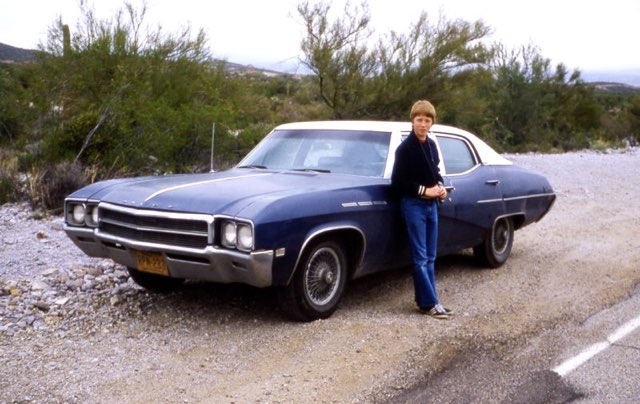
Oliver is now the same age as I was in that picture.
Six years ago today [[Oliver]] and I were on a train running across the top of Slovakia, from Kosice to Bratislava, midway through our 2009 father-and-son trip to Europe.
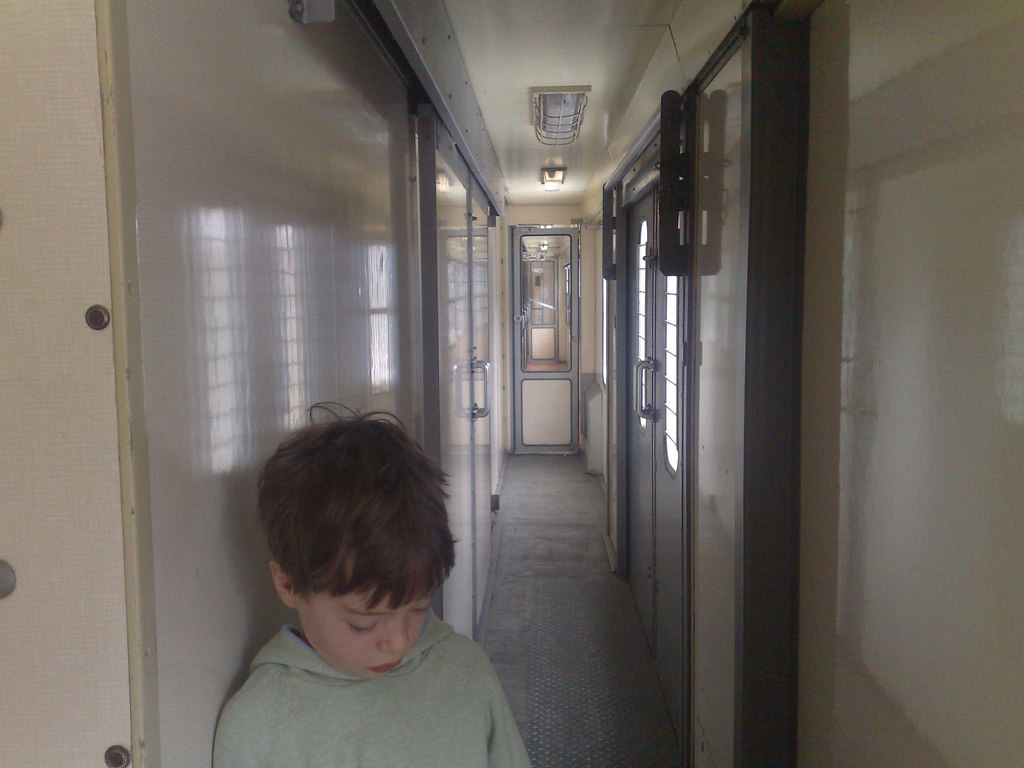
It was a crazy, wonderful trip, the first one we took together, just ourselves.
After three days in Kosice we spent a quick 24 hours in Vienna with our friend Til, and then were off to Nuremberg (highlight: PLAYMOBIL FunPark), Paris (highlight: Le Pure Café) and London, where we had a quick Thai supper with our friend Jonas before jetting home:
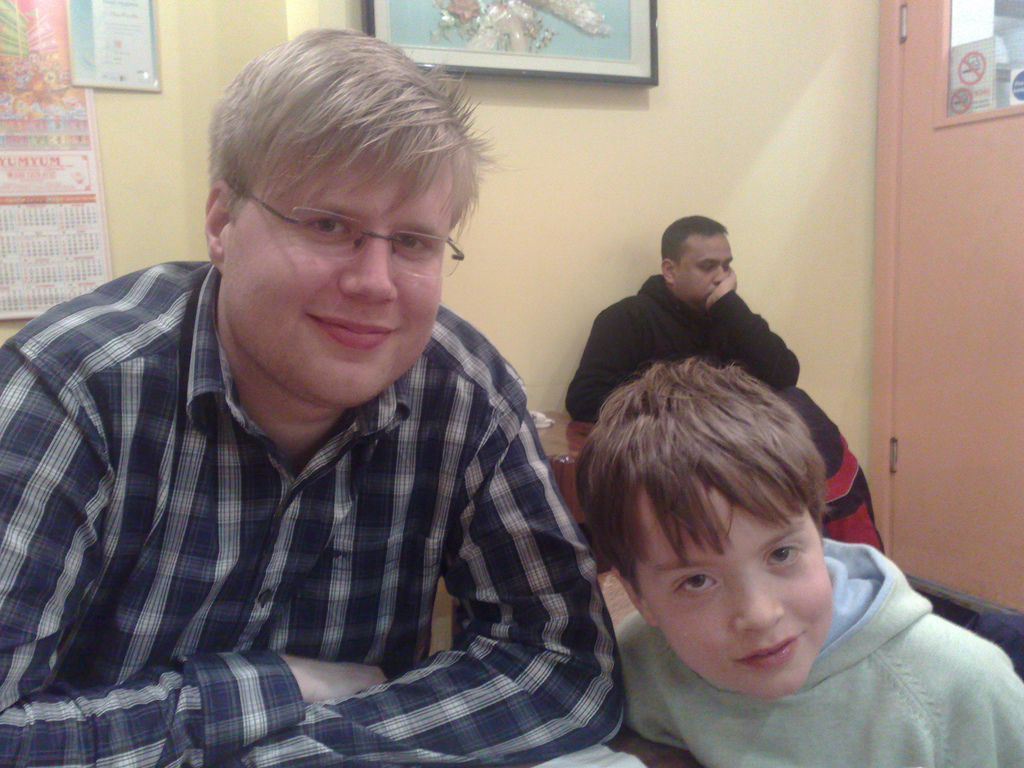
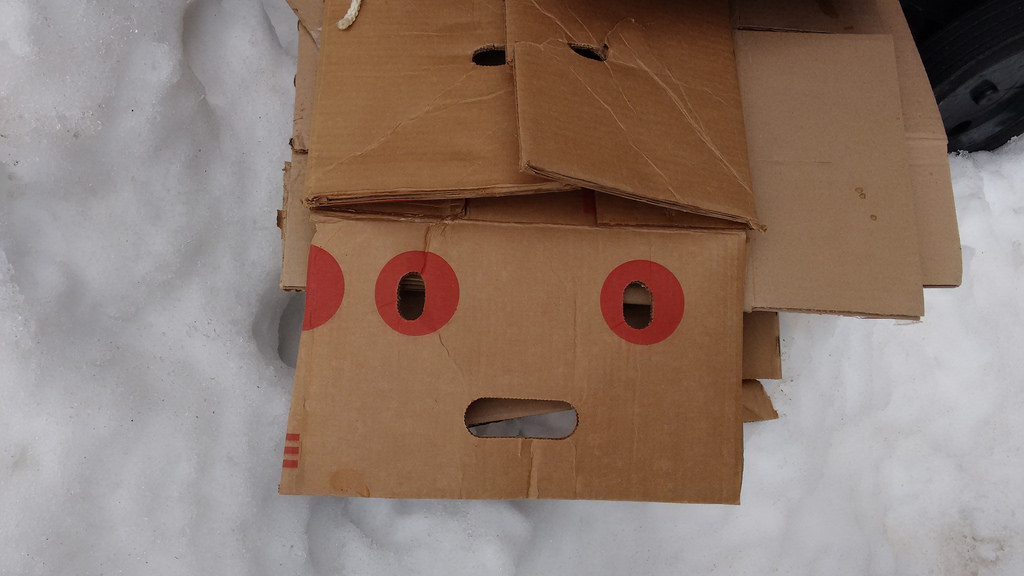
 I am
I am